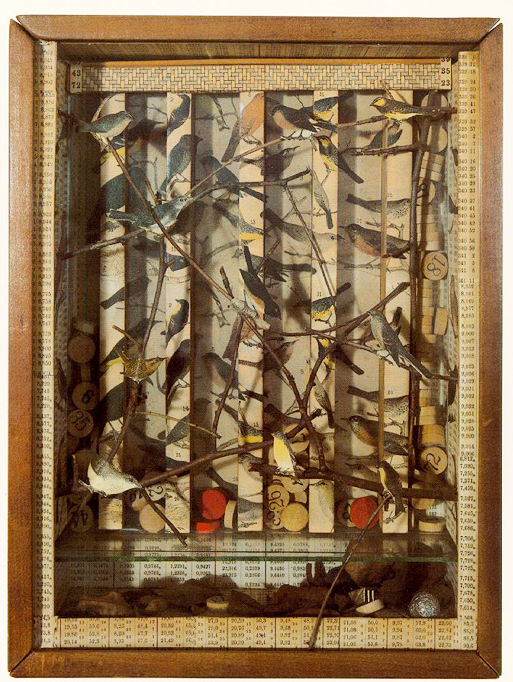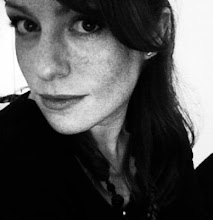
Cornell's most characteristic art works were boxed assemblages created from found objects. These are simple boxes, usually glass-fronted, in which he arranged surprising collections of photographs or Victorian bric-à-brac, in a way that combines the formal austerity of Constructivism with the lively fantasy of Surrealism. Many of his boxes, such as the famous Medici Slot Machine boxes, are interactive and are meant to be handled.

His boxes relied on the Surrealist technique of irrational juxtaposition, and on the evocation of nostalgia, for their appeal. Cornell never regarded himself as a Surrealist; although he admired the work and technique of Surrealists like Max Ernst and René Magritte, he disavowed the Surrealists' "black magic," claiming that he only wished to make white magic with his art. Cornell's fame as the leading American "Surrealist" allowed him to befriend several members of the Surrealist movement when they settled in the USA during the Second World War. Later he was claimed as a herald of pop art and installation art.

In addition to creating boxes and flat collages and making short art films, Cornell also kept a filing system of over 160 visual-documentary "dossiers" on themes that interested him; the dossiers served as repositories from which Cornell drew material and inspiration for boxes. He had no formal training in art, although he was extremely widely read and was conversant with the New York art scene from the 1940s through to the 1960s.

Joseph Cornell was wary of strangers. This led him to isolate himself and become a self-taught artist. Although he expressed attraction to unattainable women like Lauren Bacall, his shyness made romantic relationships almost impossible. In later life his bashfulness verged on the point of being considered reclusiveness, and he rarely left the state of New York. However, he preferred talking with women, and often made their husbands wait in the next room when he discussed business with them. He also had numerous friendships with ballerinas, who found him unique, but too eccentric to be a romantic partner.

His last major exhibition was a show he arranged especially for children, with the boxes displayed at child height and with the opening party serving soft drinks and cake.

He devoted his life to caring for his brother who died in 1965. This was another factor in his lack of relationships. He was also rather poor for most of his life, working during the 1920s as a wholesale fabric salesman to support his family. As a result of the American Great Depression, Cornell lost his textile industry job in 1931, and worked for a short time thereafter as a door-to-door appliance salesman. In the 1940s, Cornell also worked in a plant nursery and briefly in a defense plant, and designed covers and feature layouts for Harper's Bazaar, View, Dance Index, and other magazines. He only really began to sell his boxes for significant sums after his 1948 solo show.

Cornell became a highly regarded artist towards the end of his career, yet remained out of the spotlight. Admirers did seek him out, and on occasion he invited them to visit. Upon his death in 1972, it was one of these admirers who saved his collection from going to waste.

6 comentarios:
En el baño principal de mi casa, hay un ensamble del mismo tipo... una cajita con una especie de instalación adentro, pero con mini-toallas, jabonsitos y un diminuto retrete. Como en una casa de muñecas, la instalación consta de tres pisos; sin escaleras.
Me parece haber visto una portada de libro (de esos Sanborn's size(!!)) con la niña del globo aerostático en a portada ahí en Librerías Gandhi.
Por cierto, recibiste tu EP de Thygerlaine?
cornell ha tenido siempre la mala costumbre de enseñarme una divertida forma de cómo se puede crear un lenguaje nuevo; con guiños no para de soltarme una nueva definición de trivialidad, por eso me cayó mal lo de "...his boxes relied on the Surrealist technique of irrational juxtaposition..." ya que con mi exhaustiva búsqueda de estructuras no encuentro en él una 'irracionalidad' que me moleste...
un abrazo.
Como siempre haciendome descubrir algo nuevo... gracias Miss White!
cornell is what brought me and my present long life girl friend together. en el museo de art contemporaneo en mexico df, una exhibicion de allan white(?) presenta sus projectos igualito de cornell, obvio por ser parte del grupo surrealista.
Para Riverside:
Qué lindura que Cornell los haya juntado! Si están en México no dejen de ir a la expo de Alan GLASS en el Museo de Arte Moderno. Es para irse de espaldas... Prontamente haré un post sobre él.
Saludos!
Ferragosto
(a Cy Twombly por recordarme sus ojos)
Feroz, Agosto, feroz.
Despierto y
lo viejo de tu rojo
niño del vacío,
junto al pellejo festín
enmarcado sin cristal
separando madera y lienzo
como aguas entre bestias amantes,
vienen a mí, feroz, con el musgo de Venecia,
Agosto,
desde la capota de yeso.
Feroz, Agosto, feroz,
me armo contra el tiempo
y sus estaciones.
Vacío.
Sobre el desierto
que algunos llamaron banqueta
descienden los ojos del cielo
voraces igual sobre mi cuerpo,
Agosto,
desnudándose para recibir a la noche
sobre la cama de arena.
Vacío, niño, vacío;
Feroz, Agosto, feroz sin su voz.
Publicar un comentario